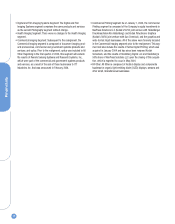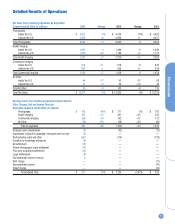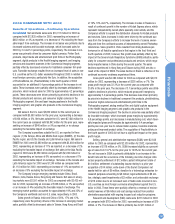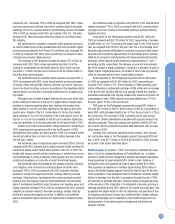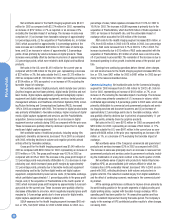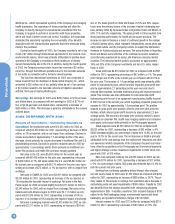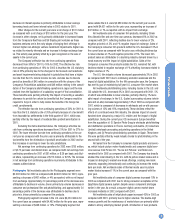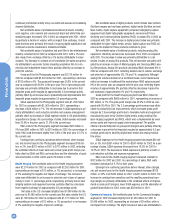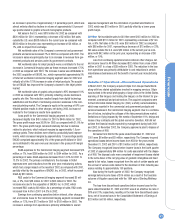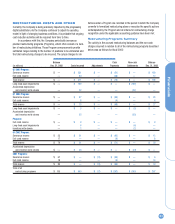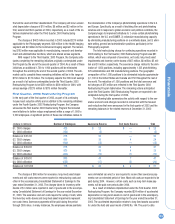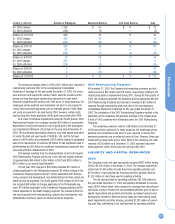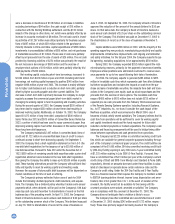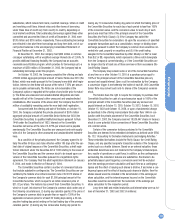Kodak 2003 Annual Report Download - page 19
Download and view the complete annual report
Please find page 19 of the 2003 Kodak annual report below. You can navigate through the pages in the report by either clicking on the pages listed below, or by using the keyword search tool below to find specific information within the annual report.
Financials
19
decrease in interest expense is primarily attributable to lower average
borrowing levels and lower interest rates in 2002 relative to 2001.
Other charges for the current year were a net charge of $101 million
as compared with a net charge of $18 million for the prior year. The
increase in other charges, net is primarily attributable to increased losses
from the Company’s NexPress and SK Display joint ventures as these
business ventures are in the early stages of bringing their offerings to
market, higher non-strategic venture investment impairments, higher loss-
es related to minority interests and an increase in foreign exchange loss-
es. This activity was partially offset by a gain recognized on the sale of
assets in the current year.
The Company’s effective tax rate from continuing operations
decreased from 30% for 2001 to 16% for 2002. The effective tax rate
from continuing operations of 16% for 2002 is less than the U.S. statutory
rate of 35% primarily due to the charges for the focused cost reductions
and asset impairments being deducted in jurisdictions that have a higher
tax rate than the U.S. federal income tax rate, and also due to discrete
period tax benefits of $45 million in connection with the closure of the
Company’s PictureVision subsidiary and $46 million relating to the consoli-
dation of the Company’s photofinishing operations in Japan and the loss
realized from the liquidation of a subsidiary as part of that consolidation.
These benefits were partially offset by the impact of recording a valuation
allowance to provide for certain tax benefits that the Company would be
required to forgo in order to fully realize the benefits of its foreign tax
credit carryforwards.
The effective tax rate from continuing operations of 30% for 2001 is
less than the U.S. statutory rate of 35% primarily because of a tax benefit
from favorable tax settlements in the third quarter of 2001, which was
partially offset by the impact of nondeductible goodwill amortization in
2001.
Excluding the items described above, the Company’s effective tax
rate from continuing operations decreased from 31% for 2001 to 27% for
2002. The lower effective tax rate from continuing operations in the cur-
rent year as compared with the prior year is primarily attributable to the
tax benefits from the elimination of goodwill amortization in 2002 and fur-
ther increases in earnings in lower tax rate jurisdictions.
Net earnings from continuing operations for 2002 were $793 million,
or $2.72 per basic and diluted share, as compared with net earnings from
continuing operations for 2001 of $81 million, or $.28 per basic and dilut-
ed share, representing an increase of $712 million, or 879%. The increase
in net earnings from continuing operations is primarily attributable to the
reasons outlined above.
Photography Net worldwide sales for the Photography segment were
$9,002 million for 2002 as compared with $9,403 million for 2001, repre-
senting a decrease of $401 million, or 4% as reported, with no net impact
from exchange. Approximately 2.0 percentage points of the decrease was
attributable to declines in volume, driven primarily by volume decreases in
consumer and professional film and photofinishing, and approximately 2.0
percentage points of the decrease was attributable to declines due to
price/mix, driven primarily by consumer film products.
Photography segment net sales in the U.S. were $4,034 million for
the current year as compared with $4,482 million for the prior year, repre-
senting a decrease of $448 million, or 10%. Photography segment net
sales outside the U.S. were $4,968 million for the current year as com-
pared with $4,921 million for the prior year, representing an increase of
$47 million, or 1% as reported, with no impact from exchange.
Net worldwide sales of consumer film products, including 35mm
film, Advantix film and one-time-use cameras, decreased 6% in 2002 as
compared with 2001, reflecting declines due to lower volumes of 2%,
negative price/mix of 3%, and 1% negative impact of exchange. Sales of
the Company’s consumer film products within the U.S. decreased 12% in
the current year as compared with the prior year, reflecting declines due
to lower volumes of 7% and negative price/mix of 5%. The lower film
product sales are attributable to a declining industry demand driven by a
weak economy and the impact of digital substitution. Sales of the
Company’s consumer film products outside the U.S. remained flat, with
declines related to negative exchange of 1% offsetting increases related to
higher volumes of 1%.
The U.S. film industry volume decreased approximately 3% in 2002
as compared with 2001 due to continuing economic weakness and the
impact of digital substitution. For the fifth consecutive year, the Company
has met its goal of maintaining full year U.S. consumer film market share.
Net worldwide photofinishing sales, including Qualex in the U.S. and
CIS outside the U.S., decreased 4% in 2002 as compared with 2001, 5%
of which was attributable to lower volumes, partially offset by 1% favor-
able impact of exchange. In the U.S., Qualex’s processing volumes (whole-
sale and on-site) decreased approximately 14% in 2002 as compared with
2001, which is composed of decreases in wholesale and on-site process-
ing volumes of 13% and 16%, respectively. These declines reflect the
effects of a continued weak film industry, the adverse impact of several
hundred store closures by a major U.S. retailer, and the impact of digital
substitution. During the current year, CIS revenues in Europe benefited
from the acquisition of: (1) Spector Photo Group’s wholesale photofinishing
and distribution operations in France, Germany and Austria, (2) ColourCare
Limited’s wholesale processing and printing operations in the United
Kingdom, and (3) Percolor photofinishing operations in Spain. These bene-
fits were partially offset by weak industry trends for photofinishing in the
second half of the year.
Net sales from the Company’s consumer digital products and servic-
es, which include picture maker kiosks/media and consumer digital serv-
ices revenue from Picture CD, “You’ve Got Pictures” and Retail.com,
remained flat in 2002 as compared with 2001. The Company has broadly
enabled the retail industry in the U.S. with its picture maker kiosks and is
focused on bringing to market new kiosk offerings, creating new kiosk
channels, expanding internationally and continuing to increase the media
burn per kiosk. Net worldwide sales of thermal media used in picture
maker kiosks increased 11% in the current year as compared with the
prior year.
Net worldwide sales of consumer digital cameras increased 10% in
2002 as compared with 2001 due to strong consumer acceptance of the
EasyShare digital camera system, despite sensor component shortages
earlier in the year. As a result, consumer digital camera market share
increased modestly in 2002 compared with 2001.
Net worldwide sales of inkjet photo paper increased 43% in 2002 as
compared with 2001, primarily due to higher volumes. The double-digit
revenue growth and the maintenance of market share are primarily attrib-
utable to strong underlying market growth, introduction of new products,



